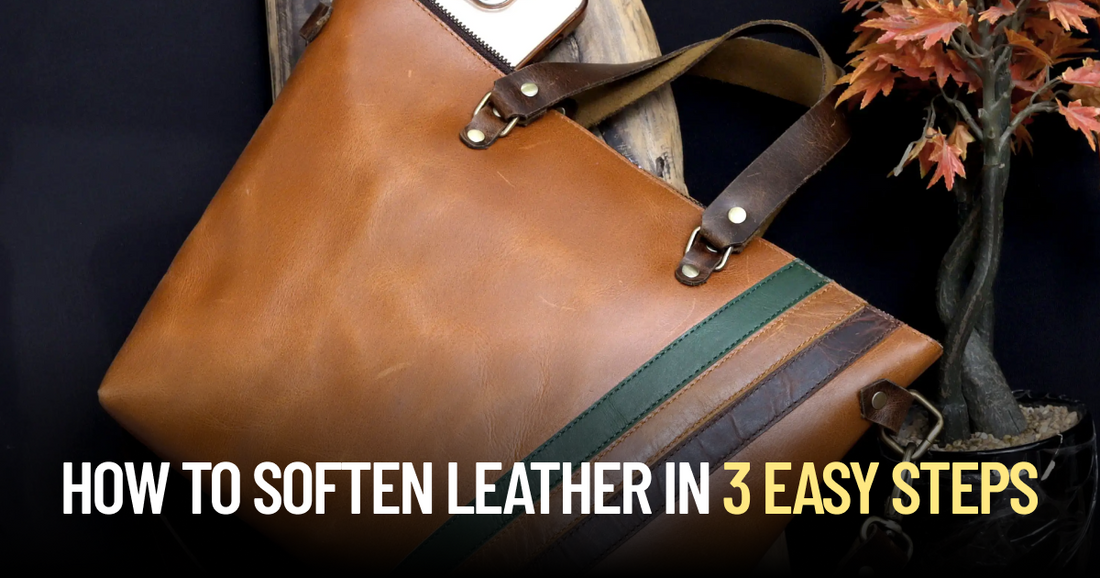Leather is loved for its durability and classic look. However, over time it can become stiff and lose its flexibility. Keeping leather soft isn’t just about appearance; it’s crucial for maintaining the material’s strength and preventing cracks. Whether you’re dealing with an old leather bag that’s lost its flexibility or you simply want to maintain your new leather jacket, knowing how to soften leather is essential. In this blog, we'll take you through three easy steps to soften leather, ensuring your items stay as comfortable and stylish as the day you bought them.
Why Softening Leather is Important
Leather is a natural material that, much like our skin, requires regular care to maintain its softness. If leather is neglected, it can become rigid and brittle, leading to cracking or permanent damage. Softening leather helps extend its lifespan, enhances its appearance, and makes it more comfortable to use.
Whether it’s softening leather bags, shoes, or jackets, proper leather care ensures that your investment stands the test of time.
Step 1: Clean the Leather
The first and perhaps most crucial step in how to soften leather is to thoroughly clean the item. Dirt, dust, and other debris can build up on the surface, hindering the softening process. Use a soft cloth or brush to wipe down the leather, and if necessary, a mild soap solution to clean deeper stains. Always ensure the leather dries naturally—avoid heat sources like radiators or hair dryers as they can further dry out the material.
Why Cleaning Before Softening is Essential
Cleaning removes surface grime that could scratch the leather during the softening process. It also ensures that any conditioner or oil applied later penetrates the leather more effectively, leading to better results. This step is particularly important when softening leather bags, as everyday use exposes them to more dirt and pollutants than other leather items.
Step 2: Apply Leather Conditioner or Natural Oils
Once your leather item is clean and dry, it's time to apply a conditioner or natural oil. There are many products designed specifically for softening leather, such as leather creams or oils. These products replenish the natural oils in the leather, restoring its flexibility and smooth texture. Gently massage the conditioner or oil into the leather using a soft cloth, ensuring even coverage, especially in areas prone to stiffness like seams or folds.
Specific Products and Techniques to Use
- Leather conditioners: These are formulated specifically for leather and are safe for all types of leather goods. Apply the conditioner in circular motions, ensuring that the product is well absorbed. A high-quality leather conditioner can not only soften the leather but also protect it from future damage.
- Natural oils: Products like coconut oil or olive oil can also be used for softening leather bags and other leather items. However, be sure to test the oil on a small, hidden part of the leather first, as some oils can darken certain types of leather.
Step 3: Let the Leather Rest and Absorb
Once you’ve applied the conditioner or oil, allow the leather to rest and absorb the treatment. Depending on the type of leather and the product used, this could take anywhere from a few hours to overnight. Be patient and avoid using the item during this time to let the product work its magic. After the leather has absorbed the conditioner, you may want to gently buff it with a soft cloth to give it a final polish.
Proper Drying Methods
Avoid placing your leather item in direct sunlight or near a heat source to speed up the drying process. This can cause the leather to dry out further, defeating the purpose of your softening efforts. Let the leather air dry naturally in a well-ventilated space. Making sure that softening leather does not cause more damage requires taking this crucial step.
How Often to Soften Leather?
The frequency of softening leather depends on the type of leather and how frequently you use the item. As a general rule, it’s a good idea to condition leather items every 3-6 months. For items like softening leather bags that are used daily and exposed to the elements, more frequent conditioning might be necessary.
However, avoid over-conditioning, as this can oversaturate the leather and lead to damage.
Best Practices for Long-Term Leather Care
- Storage: When not in use, leather goods should always be kept in a cool, dry location. Keep the leather from being folded or crumpled as this can cause creases and stiffness.
- Avoid Chemicals: Keep leather away from harsh chemicals, perfumes, and cleaning agents that can dry out the material.
- Spot Treat: If small areas become stiff, you can spot-treat them with conditioner instead of applying it to the entire item.
Conclusion: The Benefits of Regular Leather Care
Caring for your leather items regularly is the best way to keep them soft, flexible, and looking their best. Following the steps outlined in this guide will help you master how to soften leather effectively, whether it’s a vintage jacket or a brand new leather bag. You can guarantee that your leather goods stay supple and last for many years by using the right products and applying the right technique.
Softening leather isn’t just a one-time process; it’s an ongoing part of maintaining these luxurious, durable items. By cleaning, conditioning, and storing your leather goods properly, you’ll enjoy their comfort and style for a lifetime.
For long-lasting, high-quality leather care, make sure to incorporate regular cleaning and conditioning into your routine. Not only will it keep your leather soft, but it will also prevent cracking, fading, and premature aging. So, whether you're softening leather bags or caring for a beloved leather jacket, these simple steps will ensure that your leather items stay as good as new.


